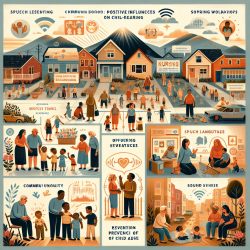Introduction
In the field of speech-language pathology, understanding the broader social determinants of child health is crucial for developing effective interventions. A recent study titled Neighborhood social capital and infant physical abuse: a population-based study in Japan provides valuable insights into how neighborhood social capital can influence the prevalence of infant physical abuse. This blog aims to help practitioners integrate these findings into their practice and encourage further research.
Key Findings from the Study
The study conducted by Fujiwara et al. (2016) involved a population-based sample of women with 4-month-old infants in Japan. It explored the relationship between neighborhood social capital and the incidence of infant physical abuse. The key findings include:
- The prevalence of infant physical abuse was 9.0% among the sample.
- Women living in neighborhoods with high levels of trust were significantly less likely to report infant physical abuse (OR 0.25, 95% CI 0.06–0.97).
- Supportive personal social networks also reduced the likelihood of abuse (OR 0.59, 95% CI 0.36–0.99).
Implications for Practitioners
For practitioners working with children and families, these findings underscore the importance of considering social factors beyond the immediate family. Here are some strategies to incorporate these insights into practice:
- Community Engagement: Encourage families to participate in community events and activities that build trust and connections among neighbors.
- Support Networks: Facilitate the development of support groups for parents, particularly those who may be isolated or lack a strong social network.
- Education and Awareness: Educate families about the benefits of strong community ties and provide resources to help them build these connections.
- Collaboration with Community Leaders: Work with local organizations and leaders to create programs that enhance social capital and provide support to families.
Encouraging Further Research
While the study provides valuable insights, there is a need for further research to explore the mechanisms through which neighborhood social capital affects infant physical abuse. Practitioners can contribute to this research by:
- Collecting data on community engagement and social networks as part of routine assessments.
- Participating in or initiating studies that examine the impact of community-based interventions on child health outcomes.
- Collaborating with researchers to explore innovative ways to strengthen community bonds and reduce child abuse.
Conclusion
The study by Fujiwara et al. highlights the protective role of neighborhood social capital against infant physical abuse. By integrating these findings into practice, speech-language pathologists and other practitioners can contribute to creating safer and more supportive environments for children. Strengthening community bonds and personal social networks should be considered essential components of interventions aimed at preventing child abuse.
To read the original research paper, please follow this link: Neighborhood social capital and infant physical abuse: a population-based study in Japan.










